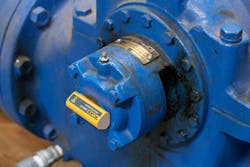One of the many reasons behind the appeal of the Industrial Internet of Things (IIoT) concept has been the promise that getting started on projects could be relatively simple. Particularly when it comes to projects that can provide quick results.
With the release of its new 3560 FC wireless vibration sensor, Fluke takes aim at this popular IIoT promise by providing a way of simplifying the process of vibration detection and performing analysis to determine potential problems. According to Fluke, the 3560 FC vibration sensor “wirelessly and remotely captures simple vibration screening data on imbalance and misalignment.”
One of the more significant aspects of this sensor is the democratization it brings to remote asset health monitoring. Fluke says that vibration monitors typically require special training or third-party experts, or impose too much of an expense to use on most equipment—all of which can lead to significant gaps in maintenance programs. A pack of 10 of these sensors sells on the Fluke site for $699.90.
Read about Fluke’s insights on why CMMS is critical to predictive maintenance.
Fluke points out that the sensor is small enough to fit into “hard-to-reach places” and can be placed on multiple locations on a piece of equipment. Though the sensors are designed for long-term use on assets, the company says they can also be removed and installed on other equipment as needed.
Data generated by the sensors is wirelessly transmitted and stored on Fluke Connect Condition Monitoring software, which is available as an app for most mobile devices, allowing maintenance teams to remotely monitor asset health. Fluke notes that the software can be used to generate automatic alerts when measurements go outside set parameters, to provide notification of vibration issues before they become critical.
This video from Fluke highlights the new 3560 FC Vibration Sensor
Leaders relevant to this article:


